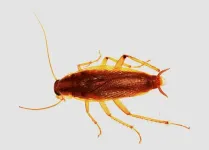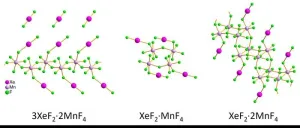(Press-News.org) A major international study has explained how bread wheat helped to transform the ancient world on its path to becoming the iconic crop that today sustains a global population of eight billion.
“Our findings shed new light on an iconic event in our civilisation that created a new kind of agriculture and allowed humans to settle down and form societies,” said Professor Brande Wulff, a wheat researcher at KAUST (King Abdullah University of Science and Technology) and one of the lead authors of the study which appears in Nature.
Professor Cristobal Uauy, a group leader at the John Innes Centre and one of authors of the study said: “This work exemplifies the importance of global collaboration and sharing of data and seeds across countries; we can achieve so much by combining resources and expertise across institutes and across international boundaries.”
The secret of bread wheat’s success, according to the research by institutes that make up the Open Wild Wheat Consortium (OWWC), lies in the genetic diversity of a wild grass called Aegilops tauschii.
Bread wheat is a hybrid between three wild grasses containing three genomes, (A, B and D) within one complex plant.
Aegilops tauschii, an otherwise inconspicuous weed, provided bread wheat’s D-genome when it crossed with early cultivated pasta wheat in the Fertile Crescent sometime between eight and eleven thousand years ago.
The chance hybridisation on the banks of the southern Caspian Sea spawned an agricultural revolution. Cultivation of bread wheat rapidly spread across a wide new range of climates and soils as farmers enthusiastically adopted this dynamic new crop, with its high gluten content that creates an airier elasticated breadmaking dough.
This rapid geographical advance has puzzled wheat researchers. There is no wild bread wheat: and the kind of hybridisation event that added the new D genome to wheat’s existing A and B genomes created a genetic bottleneck, whereby the new species had a much-reduced genetic diversity compared to its surrounding wild grasses.
This bottleneck effect coupled with the fact that wheat is an in-breeding species - meaning it is self-pollinating - would suggest that bread wheat might struggle outside its Fertile Crescent origins. So how did it become well-travelled and widely adopted across the region?
In solving this conundrum, the international collaboration assembled a diversity panel of 493 unique accessions spanning the geographical range of Aegilops tauschii from north-western Turkey to eastern China.
From this panel the researchers selected 46 accessions reflecting the species traits and genetic diversity, to create a Pangenome, a high-quality genetic map of Aegilops tauschii.
Using this map, they scanned 80,000 bread wheat landraces - locally adapted varieties - held by CIMMYT and collected from around the world.
This data showed that around 75% of the bread wheat D-genome is derived from the lineage (L2) of Aegilops tauschii which originates from the southern Caspian Sea. The remaining 25% of its genetic make-up is derived from lineages across its range.
“This 25% influx of genetic material from other lineages of tauschii has contributed and defined the success of bread wheat,” said Professor Simon Krattinger, lead author of the study.
“Without the genetic viability that this diversity brings, we would most likely not eat bread on the scale we do today. Otherwise, bread wheat today would be a regional crop - important to the Middle East but I doubt that it would have become globally dominant without this plasticity that enabled bread wheat to adapt.”
A previous study by OWWC revealed the existence of a distinct lineage of Aegilops tauschii geographically restricted to present day Georgia in the Caucasus region - 500 kilometers from the Fertile Crescent. This Aegilops tauschii lineage (L3) is significant because it has provided bread wheat with the best-known gene for dough quality.
In this study the researchers hypothesised that if this were an historic introgression, akin to a Neanderthal genetic footprint in the human genome, they would find landraces in the CIMMYT collections that had a higher proportion of it.
Data analysis showed that CIMMYT wheat landraces collected from the Georgian region contained 7% L3 introgressions in the genome, seven times more than that of bread wheat landraces collected from the Fertile Crescent.
“We used the L3 tauschii accessions as a guinea pig to track and trace the hybridizations using 80,000 bread wheat landraces,” said Professor Krattinger.
“The data beautifully supports a picture where bread wheat emerges in the southern Caspian, then with migration and agricultural expansion it reached Georgia and here with gene flow and hybridisations with the peculiar, genetically distinct and geographically restricted L3 accessions it resulted in the influx of new genetic material.”
“This is one of the novel aspects of our study and it confirms that using our new resources we can trace the dynamics of these introgressions in bread wheat.”
In addition to solving this age-old biological mystery the new Aegilops tauschii open source Pangenome and germplasm made available by the OWWC, are being used by researchers and breeders worldwide to discover new disease resistance genes that will protect wheat crops against age-old agricultural plagues like wheat rust. They can also mine this wild grass species for climate resilient genes which can be bred into elite wheat cultivars.
Researchers at the John Innes Centre worked closely with colleagues from KAUST using bioinformatic approaches to track levels of DNA contributed to bread wheat by the L3 lineage of Aegilops tauschii.
Professor Uauy concluded: “The study highlights the importance of maintaining genetic resources such as the BBSRC funded Germplasm Resources Unit here at the John Innes Centre which maintains historic collections of wild grasses that can be used to breed valuable traits such as disease resistance and pest resistance into modern wheat.”
Origin and evolution of the bread wheat D genome appears in Nature.
END
How bread dough gave rise to civilization
2024-08-14
ELSE PRESS RELEASES FROM THIS DATE:
Revealing the mysteries within microbial genomes
2024-08-14
A new technique developed at Lawrence Berkeley National Laboratory (Berkeley Lab) will make it much easier for researchers to discover the traits or activities encoded by genes of unknown function in microbes, a key step toward understanding the roles and impact of individual species.
The approach, called barcoded overexpression bacterial shotgun library sequencing, or Boba-seq, is described in a paper published August 5 in Nature Communications.
“There is so much genetic dark matter – ...
Consumer-grade insecticide sprays fail to control cockroaches, study shows
2024-08-14
Annapolis, MD; August 14, 2024—A common variety of consumer insecticide sprays is mostly ineffective and of "little to no value" in eliminating cockroach infestations, a new study shows.
Residual insecticides are designed to be sprayed on surfaces where cockroaches are likely to appear, exposing them to the toxic ingredient when they move across the surface later. But laboratory testing by researchers at the University of Kentucky and Auburn University shows that the residues have little effect on German cockroaches (Blattella germanica), ...
Children’s Hospital of Philadelphia researchers find possible inaccuracies in crash-reported child passenger injuries
2024-08-14
Philadelphia, August 14, 2024 – Researchers from the Center for Injury Research and Prevention (CIRP) at Children’s Hospital of Philadelphia (CHOP) found discrepancies between crash reports and hospital data that might paint an incomplete or inaccurate picture of how crashes impact the safety of child passengers. Enhancing the quality of injury data reported in crash reports can aid researchers in assessing the effectiveness of various transportation safety strategies for children. The findings were recently published by ...
Ontario Institute for Cancer Research announces awards for eight research teams developing innovative ways to diagnose and treat cancer
2024-08-14
August 14, 2024, TORONTO — A new round of awards from the Ontario Institute for Cancer Research (OICR) will jumpstart eight promising studies that could change how cancers are diagnosed and treated.
OICR announced the results of its Pre-Clinical Acceleration Team Awards — part of the Institute’s Clinical Translational Pathway, which helps advance new discoveries so they can benefit people affected by cancer.
The winning research teams are based across Ontario and are tackling some of the most common and hardest to treat cancers. They are developing solutions to find cancer earlier, diagnose it more ...
People with COPD, asthma have higher risk of health problems from increased wildfire activity, smoke
2024-08-14
MIAMI (August 14, 2024) – Communities impacted by increased wildfire activity and smoke can use a population health-based action plan to help alleviate health risks, particularly for those with chronic obstructive pulmonary disease (COPD) and asthma, according to a new perspective article. The article is published in the July 2024 issue of Chronic Obstructive Pulmonary Diseases: Journal of the COPD Foundation, a peer-reviewed, open-access journal.
COPD is an inflammatory lung disease, comprising several conditions, ...
Early life exposure to common chemical permanently disrupts gut microbiome
2024-08-14
UNIVERSITY PARK, Pa. — Early life exposure to ‘forever chemicals’ in the environment permanently disrupts the gut microbiome in mice, contributing to the development of metabolic disease in later life, according to new research led by Penn State. The results, published today (Aug. 14) in the journal Environmental Health Perspectives, suggest that human exposure to these chemicals during early childhood may be contributing to the recent epidemic of metabolic disorders, including obesity and type 2 diabetes among adults.
The researchers focused specifically on 2,3,7,8-tetrachlorodibenzofuran ...
Rocks collected on Mars hold key to water and perhaps life on the planet. Bring them back to Earth.
2024-08-14
Over the course of nearly five months in 2022, NASA's Perseverance rover collected rock samples from Mars that could rewrite the history of water on the Red Planet and even contain evidence for past life on Mars.
But the information they contain can't be extracted without more detailed analysis on Earth, which requires a new mission to the planet to retrieve the samples and bring them back. Scientists hope to have the samples on Earth by 2033, though NASA's sample return mission may be delayed.
"These samples are the reason why our mission was flown," said paper ...
Nighttime light data shows inequities in restoring power after Hurricane Michael
2024-08-14
Among the many devasting impacts in the aftermath of a hurricane are power outages, which can take days or even weeks to restore. Communities grappling with the loss of electricity may encounter obstacles in accessing vital services, including food, fuel and health care.
In 2018, Hurricane Michael, a Category 5 storm, wreaked havoc in Florida as it made landfall in the United States. It was strongest recorded to hit the Florida Panhandle with winds of nearly 161 miles per hour and storm surge reaching heights ...
Rising mercury pollution in soil could be related to climate change, study says
2024-08-14
In 2017, the Minamata Convention on Mercury went into effect, designed to help curb mercury emissions and limit exposure across the globe. However, a new study of mercury levels in soil suggests that the treaty’s provisions might not be enough. The study published in ACS’ Environmental Science & Technology estimates that soil stores substantially more mercury than previously thought, and it predicts that increases in plant growth due to climate change may add even more.
Mercury is a persistent environmental pollutant, moving through air, water and soil, and accumulating within plants ...
Exploring the structures of xenon-containing crystallites
2024-08-14
Noble gases have a reputation for being unreactive, inert elements, but more than 60 years ago Neil Bartlett demonstrated the first way to bond xenon. He created XePtF6, an orange-yellow solid. Because it’s difficult to grow sufficiently large crystals that contain noble gases, some of their structures — and therefore functions — remain elusive. Now, researchers have successfully examined tiny crystallites of noble gas compounds. They report structures of multiple xenon compounds in ACS Central ...





